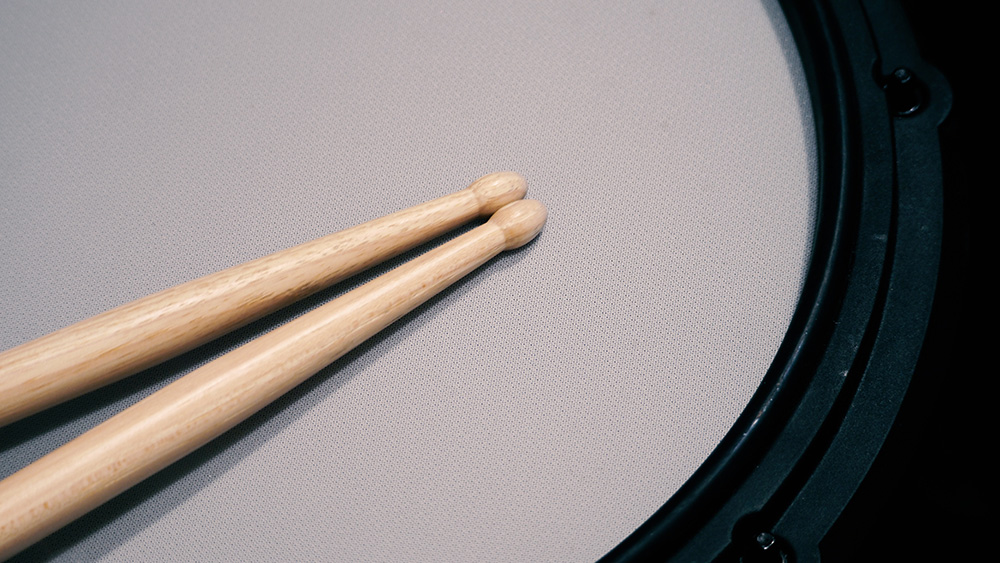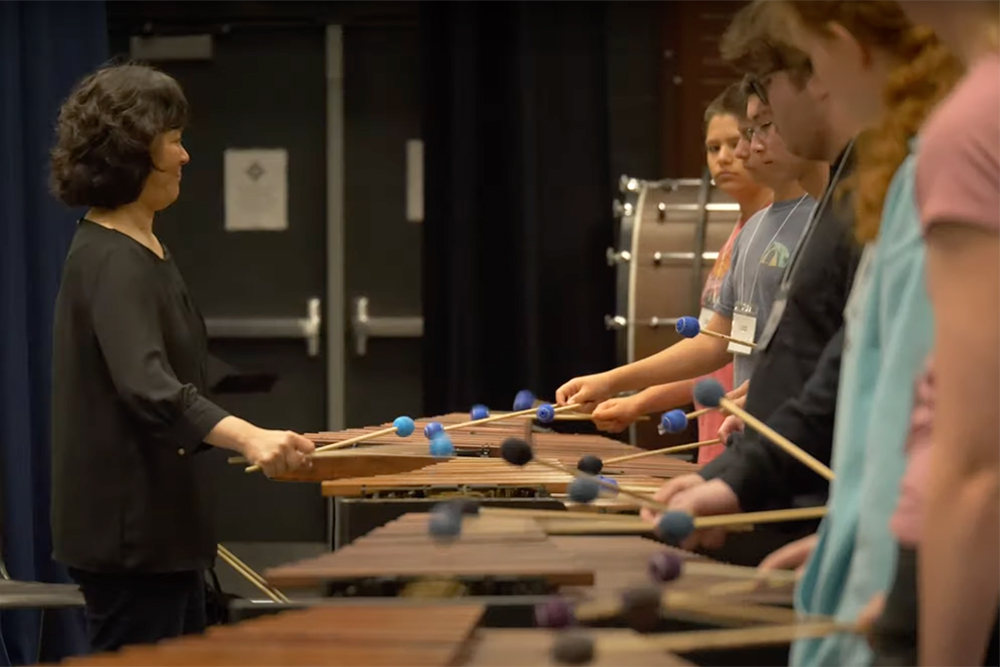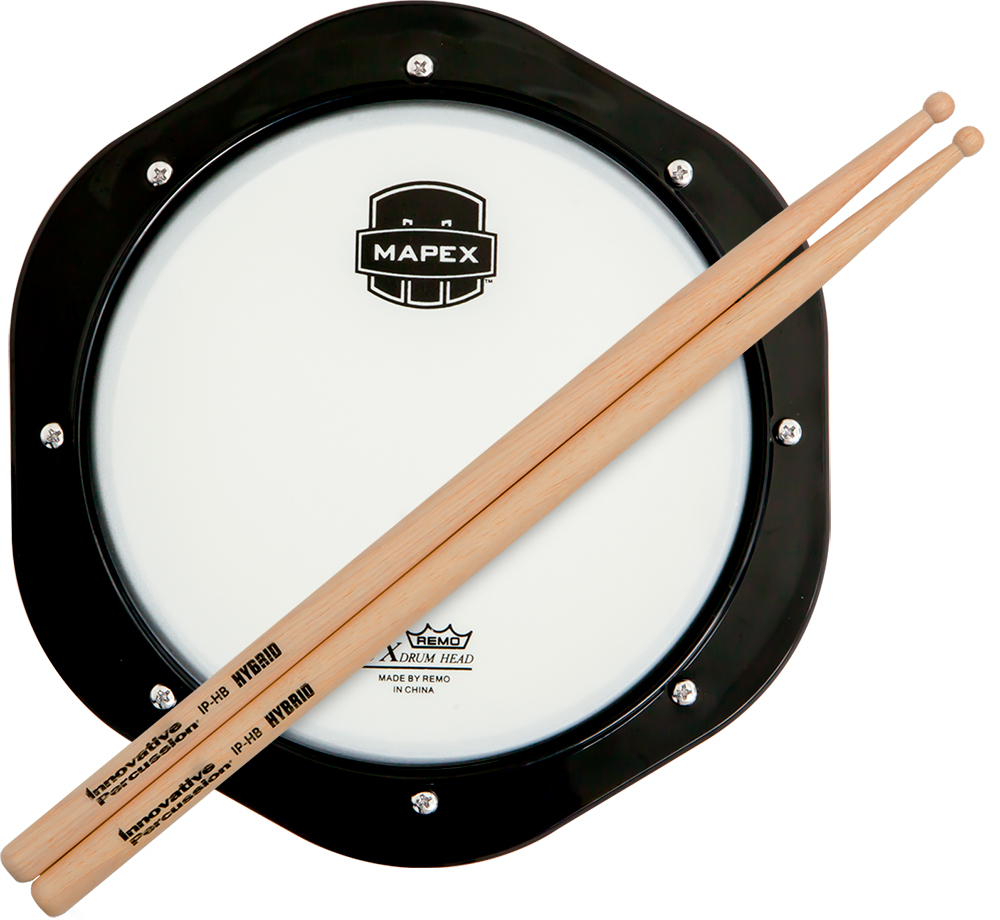One of the biggest questions in beginning percussion pedagogy is when to start mallets vs when to start drumming on a practice pad. This is an important question that is inspired by different experiences across band halls everywhere. Percussionists show up in the back of the room with an awful lot of responsibility to keep time, set things up, and move around to different stations seamlessly. They are also tasked with playing different instruments that are in fact related but, in some ways, very different, including various membranophones (drums) and mallet instruments. There are, of course, accessory instruments and also timpani (an entirely different beast in itself), but for now, I’ll just focus on drums and mallets.

Many times, the perception with percussionists is that they are more capable of playing instruments such as snare drum, bass drum, or toms and less capable of playing mallet instruments such as marimba and xylophone. This can cause frustration with the educator managing those rehearsals as the reading ability can often be deficient. When these deficiencies are present percussionists will lean towards memorization first causing a gap in time between when they receive the music and when they are able to perform it. The initial success of playing drums is partially attributed to a larger natural tolerance in technical proficiency. This means that a student without correct grip, approach, or technique can experience a level of success in the very early stages on these instruments if equipped with a good of sense of time naturally. This will get those parts played, but the lack of technique will make it difficult to progress later when more advanced skills are required, such as rolls or rudiments. Mallets, on the other hand, can’t be approached at all without a certain knowledge base. This includes the ability to read music, as well as understanding and navigating the instrument geography itself. Also, the mechanics of moving the correct hinges or the wrists are an absolute requirement. So, what is the right thing to do? Should I start mallets first? Should I start percussionists on practice pads and mallets at the same time? …OR…should I start them drumming on a pad first? In my experience, the answer is unequivocally starting with pad first.

Sometimes, when your percussionists have trouble reading and playing mallets, the natural inclination is to start them on mallets first. I do understand both the emotional reaction and the logic on the surface, but there are some important things to consider. The most important of these is the goal of creating a good overall percussionist and this starts with a sound mechanical development. Percussionists must be able to use their hands in the correct way. This includes posture, arm slot (arm and elbow placement), the correct primary hinge (wrists), grip, and the ability to produce rebound with the fulcrum. Without these foundational concepts, the ceiling for a percussionist becomes very low almost immediately. It is very difficult if not impossible to be a good mallet player without the correct mechanics and technique. This is much more easily established on a pad. When students are started on mallets first, the goals are centered around hitting the correct notes at the correct times, but the instrument does not lend itself to establishing basic technique. For example, on a pad/snare drum, the most basic stroke is the rebound stroke which is sometimes referred to as the legato stroke or full stroke. When a percussionist learns this stroke, it should start in the up position and then be propelled by the wrist towards the head. When it strikes the head, the fulcrum and relaxation in the grip should allow the stick to bounce back or rebound to the up position where it started. This is the most important stroke in percussion and needs to be developed thoroughly for success. On mallets, the bars do not provide rebound which is why the basic mallet stroke that starts in the up position and ends in the up position is referred to as the piston stroke. The very idea of the piston stroke is to imitate the movement and feel of the rebound stroke.
That is the most common way that this skill is taught. If the rebound stroke is not introduced, installed properly, reinforced, and eventually proficient, it is not possible to imitate it on mallets in the form of the piston stroke. This is perhaps the most fundamental reason for starting on pad. If mallets are started first, it negates the entire pathway to the piston stroke.
Another strategy is to start at the same time. To define this, by starting at the same time; I am referring to playing the mallet instrument alternating with playing the pad immediately either within the same day, every other day, or by week. I would not recommend this approach for one specific reason: In the crucial phases of installing technique, the mallet instrument itself, even in small doses of attempting to play, can dramatically slow and even stifle the process of learning the necessary movement skills in percussion. Again, these movement skills translate to mallets just as much as pad, and without them, they will not be able to eventually perform even moderately technical skills or literature on a mallet instrument with a characteristic sound or accurate rhythm.

The approach that I recommend would be to start on a pad only while carefully cultivating the physical skills necessary to approach the instrument. A good time period of playing the pad exclusively can be anywhere from 6 weeks to 2 months. The key to this strategy is to introduce the building blocks of mallets purely from a theory approach while laying the foundation for technique, timing, and rhythm, both playing and reading on the pad. I follow a path that introduces the musical alphabet and includes seeing it vertically and horizontally as well as reciting it forwards and backwards. From there, you can more easily approach the staff and the layout of the instrument, eventually including intervals, octaves, and enharmonics. By the time my students pick up mallets to play for the first time, they know all of the notes on the staff fairly well, and also where they are located on the instrument. Most importantly, they understand how to use their hands correctly when they begin playing. This changes the dynamic of playing mallets completely. The lack of enthusiasm to play mallets which is so often expressed by students typically stems from their lack of understanding and being generally intimidated by the instrument. Separating the responsibilities of learning to play the instrument from the responsibilities of learning all of the theory behind the instrument can make a huge difference for many beginning percussionists. I have found this to be a key component to my students being more comfortable with mallets from the beginning, placing them in a posture of learning instead of a posture of defense.
Starting on a pad first really gives each student the opportunity to learn important phases of percussion in smaller more digestible pieces. I think that you will find your students ending up more capable in the future and more optimistic about playing mallet instruments immediately. My goal with beginners is to raise the floor, but more importantly, to raise the ceiling. Reading mallet instrument music is a challenge in itself for young percussionists but try not to let that impact your decision of what to start with in a way that sacrifices long term success. In the long run, you’ll end up producing better musicians in your percussion section by following this approach.
Want to learn more about John Bingaman's Firm Foundations For The Beginning Percussionist?
About the Author
JOHN BINGAMAN holds a Bachelor’s degree in Music Education from the University of Louisiana at Monroe and currently serves as Associate Band Director and Director of Percussion Studies at Byron Nelson High School in Trophy Club, TX. His drumlines have achieved high placements at numerous competitions across Texas, and his programs have consistently been represented with percussionists in Texas All-State bands. John is an active percussionist, drumset player, adjudicator, and has presented percussion clinics at TMEA, Art of Teaching Music Symposium, Stryvemind Director Symposium, the Texas Bandmasters Association Convention, and the Midwest Clinic.
For more information on the concepts presented here, check out John’s website and his new book “Firm Foundations for the Beginning Percussionist” at JB Publications – Percussion, Music, Print Music (jbpublish.com).
The content of this Blog article or Banded Story is the intellectual property of the author(s) and cannot be duplicated without the permission of KHS America and/or the author(s). Standard copyright rules apply.

